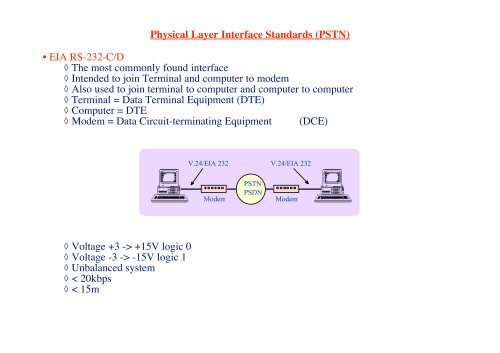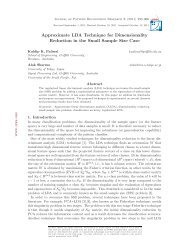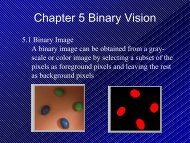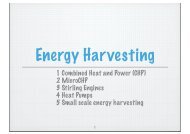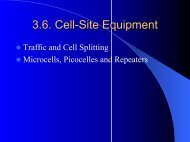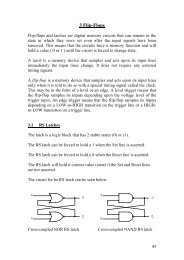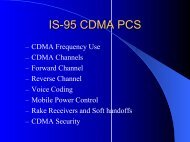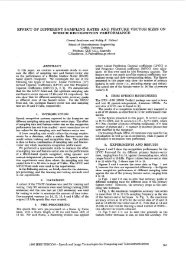Physical Layer Interface Standards (PSTN) ⢠EIA RS-232-C/D The ...
Physical Layer Interface Standards (PSTN) ⢠EIA RS-232-C/D The ...
Physical Layer Interface Standards (PSTN) ⢠EIA RS-232-C/D The ...
You also want an ePaper? Increase the reach of your titles
YUMPU automatically turns print PDFs into web optimized ePapers that Google loves.
<strong>Physical</strong> <strong>Layer</strong> <strong>Interface</strong> <strong>Standards</strong> (<strong>PSTN</strong>)• <strong>EIA</strong> <strong>RS</strong>-<strong>232</strong>-C/D◊ <strong>The</strong> most commonly found interface◊ Intended to join Terminal and computer to modem◊ Also used to join terminal to computer and computer to computer◊ Terminal = Data Terminal Equipment (DTE)◊ Computer = DTE◊ Modem = Data Circuit-terminating Equipment (DCE)V.24/<strong>EIA</strong> <strong>232</strong> V.24/<strong>EIA</strong> <strong>232</strong>Modem<strong>PSTN</strong>PSDNModem◊ Voltage +3 -> +15V logic 0◊ Voltage -3 -> -15V logic 1◊ Unbalanced system◊ < 20kbps◊ < 15m
Line designationCCITT circuit125 RI108 DTR111 TxClk114 TxClk115 RxClk109 CD102 SIG107 DSR106 CTS105 RTS104 RxD103 TxD101 SHGPin222016151787654321Ring Indication RIData Terminal Ready DTRTransmit Data Timing DTE SourceTransmit Data Timing DCE SourceReceive Data TimingCarrier Detect CDSignal Ground SIGData Set Ready DSRClear To Send CTSRequest To Send RTSReceive Data RxDTransmit Data TxDShield Ground SHG◊ <strong>RS</strong>-<strong>232</strong>-D (1987) defines extra signals for loopback testing
Connector designation◊ Under <strong>RS</strong>-<strong>232</strong>-C a number of connector may be used the most common being theDB25 (ISO 2110)◊ <strong>RS</strong>-<strong>232</strong>-D specifies this connector only1DTE connector25125DCE connector
<strong>RS</strong><strong>232</strong>/V.24 <strong>PSTN</strong> <strong>RS</strong><strong>232</strong>/V.24DTE DCE DCE DTEDTR onDSR onCD onRxDCD offRTS onDial digitsCarrier onData tonesCarrier offDTR onRI onRTS onCTS onTxDRTS offCTS offCD on.CTS onTxDRTS offCTS offCD offDSR offData tonesCarrier offRxDRTS offCTS offCD offDTR offDSR offDTR onDSR off
• V.24◊ Defined by CCITT◊ <strong>RS</strong>-<strong>232</strong> basically compatible with V.24◊ Most apparent difference is pin or circuit identifiers◊ Use CCITT circuit numbers• V.28◊ Same as <strong>RS</strong>-<strong>232</strong>C except has faster rise and fall timesIn summary the <strong>RS</strong>-<strong>232</strong>D standard isElectrical CCITT V.28Functional CCITT V.24Mechanical ISO 2110Procedural CCITT V.24
• <strong>The</strong> Null modem◊ Often wish to connect two DTE's together directly◊ Terminal -> computer◊ Computer -> printer etc◊ V.24 or <strong>RS</strong>-<strong>232</strong> data circuits must be reversed◊ Control circuits must be fooledRIDTRCDSIGDSRCTSRTSRxDTxDSHGRIDTRCDSIGDSRCTSRTSRxDTxDSHG
• <strong>RS</strong>-423-A◊ An electrical standard◊ Unbalanced line◊ NRZ L◊ 0 = +2 to +6 volts◊ 1 = -2 to -6 volts◊ 3kbps @ 1000m◊ 300kbps @ 10m◊ Compatible with V.10, X26• <strong>RS</strong>-422-A◊ Balanced line◊ NRZ L◊ 0 = +2 to +6 volts◊ 1 = -2 to -6 volts◊ 100kbps @ 1200m◊ 10Mbps @ 12m◊ Compatible with X.27, V.11◊ Multidrop as <strong>RS</strong>-485
• <strong>RS</strong>-449◊ Intended to replace <strong>RS</strong>-<strong>232</strong>◊ Uses <strong>RS</strong>-422 and <strong>RS</strong>-423 electrical standards◊ Specified up to 2Mbps◊ 37 circuits (large footprint)◊ ISO 4902 connector◊ Not popular137
• <strong>EIA</strong>-530◊ Uses <strong>RS</strong>-422 and <strong>RS</strong>-423◊ 20kbps to 2Mbps◊ 25 circuits almost identical to <strong>RS</strong>-<strong>232</strong>-D◊ DB-25 connector (ISO 2110)◊ 422 for signalling◊ 423 for loopback and test signals• V.35◊ Intended for high speed connection between high speed wideband modems and a DTE◊ 34 pin connector◊ 48 - 168 kbps◊ Signalling circuits <strong>RS</strong>-422◊ Control circuits <strong>RS</strong>-<strong>232</strong>◊ Can run over long distance when only using signal lines◊ Normally associated with V.35 modem (48000 bps)<strong>The</strong>se are a few of the interfaces used to access <strong>PSTN</strong> lines via modems. Many more specialisedinterfaces exist. See some later.
USB (Universal Serial Bus)USB2 480, 12 and 1.5 Mb/sSee maxwell for full specificationUSB Specification Rev 2
OverviewITU - T V seriesTelephoneV.24/<strong>EIA</strong>-<strong>232</strong>DWidebandV.35/<strong>EIA</strong>-5302/4 wireleasedV.23 600 or 1200 bpsV.26 1200 or 2400 bpsV.27 2400 or 4800 bpsV.29 4800 or 9600 bpsV.33 14400 bps2 wireswitchedV.21 300/300 bps duplexV.22 1200/1200 bps duplexV.22 bis 2400/2400 bps duplexV.23A 75/1200 bps duplexV.29 4800/9600 bps duplexV.32 4800/9600 bps duplexV.32 bis 14400 bpsV.34 28800 bpspoint to pointV.36 48 kbpsV.37 72-168 kbps


